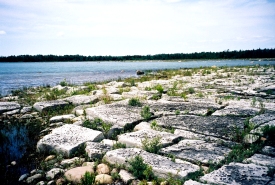Manitoulin Island Archipelago Natural Area

Southern Manitoulin Island coast, Ontario (Photo by NCC)
Conserving globally significant habitats and species
The Manitoulin Island Archipelago Natural Area is globally significant. Its undeveloped Great Lakes shorelines and rare habitats support several species at risk, such as lakeside daisy and Hill's thistle.
Conservation values
The Manitoulin Island region has the greatest richness of globally significant species and communities of any geographic region on the Canadian side of the Great Lakes Basin. Manitoulin's intact natural landscapes support a very good abundance of endemic, disjunct and globally rare species. Some of the best examples of ecological communities that are found nowhere else in the world are found on Manitoulin. This includes globally significant alvar habitat.
The island is also an important staging area for colonial nesting waterbirds and migratory birds. Several bylaws govern light use in several of the island's townships, under the Dark Sky Initiative.
Conservation status
Despite the extraordinary natural values of Manitoulin Island, less than four per cent of the island is conserved. This leaves some of the most ecologically important and sensitive areas of the island vulnerable to degradation — especially coastal habitats.
The Nature Conservancy of Canada (NCC) is working with a number of conservation partners, including local naturalists, to protect key habitats on the island. Together, they are working to ensure that Ontario's natural heritage is conserved for our children and grandchildren. Most recently, NCC conserved almost half of Cockburn Island; a historic conservation project in Ontario.




